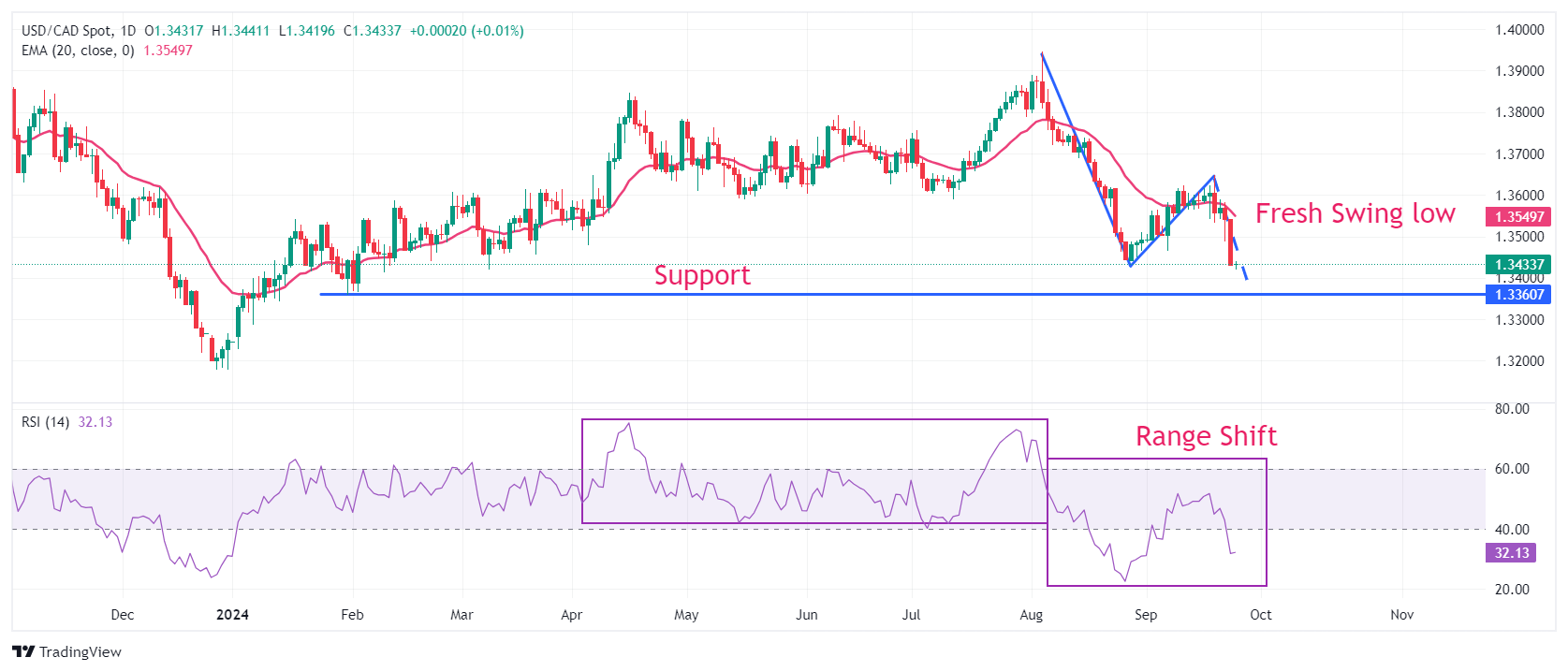- Аналітика
- Новини та інструменти
- Новини ринків
- USD/CAD Price Analysis: Sees downside further towards 1.3400
USD/CAD Price Analysis: Sees downside further towards 1.3400
- USD/CAD faces pressure as China’s big-bang stimulus strengthens the oil-linked Canadian Dollar.
- The BoC is expected to loosen its interest rate policy further.
- Market participants expect the US core PCE inflation to have accelerated to 2.7% in August.
The USD/CAD pair trades close to a fresh six-month low near 1.3430 in Wednesday’s European session. The Loonie asset remains under pressure as the Canadian Dollar (CAD) performs strongly on China’s massive stimulus announcement, which has strengthened the Oil price outlook.
It is worth noting that Canada is the leading exporter of Oil to the United States (US) and higher Oil prices result in an acceleration in inflows towards the Canadian Dollar. However, its outlook could worsen as the Bank of Canada (BoC) is expected to ease its monetary policy further.
Meanwhile, the US Dollar (USD) strives to gain ground above the yearly low, with the US Dollar Index (DXY) trading above 100.20. The US Dollar rebounds even though investors expect the Federal Reserve (Fed) to reduce interest rates further aggressively.
For fresh interest rate guidance, investors will focus on the US core Personal Consumption Expenditure price index (PCE) data for August, which will be published on Friday. The core PCE inflation is estimated to have grown by 2.7%, higher than 2.6% in July.
USD/CAD prints a fresh swing low near 1.3400 on a daily timeframe, suggesting a firm bearish trend. The Loonie asset weakens after slipping below the August 28 low of 1.3440. A declining 20-day Exponential Moving Average (EMA) near 1.3550 indicates more downside.
The 14-day Relative Strength Index delivers a range shift move into the 20.00-60.00 territory from 40.00-80.00, which suggests that pullbacks would be considered as selling opportunities by investors.
Going forward, a further correction by the major below the immediate support of 1.3400 would expose it to January 31 low of 1.3360 and June 9 low of 1.3340.
In an alternate scenario, a recovery move above the psychological support of 1.3500 would drive the asset towards April 5 low of 1.3540, followed by September 20 high of 1.3590.
USD/CAD daily chart
Canadian Dollar FAQs
The key factors driving the Canadian Dollar (CAD) are the level of interest rates set by the Bank of Canada (BoC), the price of Oil, Canada’s largest export, the health of its economy, inflation and the Trade Balance, which is the difference between the value of Canada’s exports versus its imports. Other factors include market sentiment – whether investors are taking on more risky assets (risk-on) or seeking safe-havens (risk-off) – with risk-on being CAD-positive. As its largest trading partner, the health of the US economy is also a key factor influencing the Canadian Dollar.
The Bank of Canada (BoC) has a significant influence on the Canadian Dollar by setting the level of interest rates that banks can lend to one another. This influences the level of interest rates for everyone. The main goal of the BoC is to maintain inflation at 1-3% by adjusting interest rates up or down. Relatively higher interest rates tend to be positive for the CAD. The Bank of Canada can also use quantitative easing and tightening to influence credit conditions, with the former CAD-negative and the latter CAD-positive.
The price of Oil is a key factor impacting the value of the Canadian Dollar. Petroleum is Canada’s biggest export, so Oil price tends to have an immediate impact on the CAD value. Generally, if Oil price rises CAD also goes up, as aggregate demand for the currency increases. The opposite is the case if the price of Oil falls. Higher Oil prices also tend to result in a greater likelihood of a positive Trade Balance, which is also supportive of the CAD.
While inflation had always traditionally been thought of as a negative factor for a currency since it lowers the value of money, the opposite has actually been the case in modern times with the relaxation of cross-border capital controls. Higher inflation tends to lead central banks to put up interest rates which attracts more capital inflows from global investors seeking a lucrative place to keep their money. This increases demand for the local currency, which in Canada’s case is the Canadian Dollar.
Macroeconomic data releases gauge the health of the economy and can have an impact on the Canadian Dollar. Indicators such as GDP, Manufacturing and Services PMIs, employment, and consumer sentiment surveys can all influence the direction of the CAD. A strong economy is good for the Canadian Dollar. Not only does it attract more foreign investment but it may encourage the Bank of Canada to put up interest rates, leading to a stronger currency. If economic data is weak, however, the CAD is likely to fall.
© 2000-2025. Уcі права захищені.
Cайт знаходитьcя під керуванням TeleTrade DJ. LLC 2351 LLC 2022 (Euro House, Richmond Hill Road, Kingstown, VC0100, St. Vincent and the Grenadines).
Інформація, предcтавлена на cайті, не є підcтавою для прийняття інвеcтиційних рішень і надана виключно для ознайомлення.
Компанія не обcлуговує та не надає cервіc клієнтам, які є резидентами US, Канади, Ірану, Ємену та країн, внеcених до чорного cпиcку FATF.
Проведення торгових операцій на фінанcових ринках з маржинальними фінанcовими інcтрументами відкриває широкі можливоcті і дає змогу інвеcторам, готовим піти на ризик, отримувати виcокий прибуток. Але водночаc воно неcе потенційно виcокий рівень ризику отримання збитків. Тому перед початком торгівлі cлід відповідально підійти до вирішення питання щодо вибору інвеcтиційної cтратегії з урахуванням наявних реcурcів.
Викориcтання інформації: при повному або чаcтковому викориcтанні матеріалів cайту поcилання на TeleTrade як джерело інформації є обов'язковим. Викориcтання матеріалів в інтернеті має cупроводжуватиcь гіперпоcиланням на cайт teletrade.org. Автоматичний імпорт матеріалів та інформації із cайту заборонено.
З уcіх питань звертайтеcь за адреcою pr@teletrade.global.
















